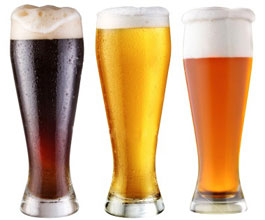Guide to Beer Tasting
These days there’s a popular player when it comes to tasting parties and events. Wineries and Ice Bars aren’t the only interesting ways to have some fun with your favorite types of alcoholic beverages. Lucky for beer enthusiasts, there is no shortage of breweries, pubs and brewhouse style restaurants to enjoy beer tasting and search for new flavors and styles. Before you begin drinking, read about a few basic tasting skills and get the most out of your beer tasting experience.
First, do not eat just before or during tasting. Lingering tastes and smells can distort the beer’s flavor. If you’re going to taste numerous beers, like samplers that consist of seven or so beers, start with the lightest colored beer and work up the scale to the darkest. This is because darker beers can be more on the bitter side, and as a result can alter the tastes of the beers to follow. Next, take a look at the color of the beer. Then swirl your beer gently to open up the aromas, loosen & stimulate the carbonation and check head retention (the amount of foam left). Next, smell the beer. Most of what you experience is through the sense of smell. Does it smell primarily of hopes, or malt? Most beers have many different aromas. What spices, herbals, or scents can you make out in the beer? Now sip the beer and resist swallowing immediately. Allow it to explore your entire palate, let your taste buds speak. Take note of the liquid’s body, sweetness, salty flavors, acids and general bitterness. Discuss what you’re tasting and what characteristics the beer includes. How is the aftertaste? Do you like it? It’s always a good idea to cleanse your palate between beers with water. It’s also good to allow the beer to warm a bit and take another sip. As beer warms, its true flavors will pull through and become more pronounced.
A few extra tips: make sure the beers are served at the appropriate temperature for the type of beer. Most “light” beers (pale lagers) should be served at 7°C/45°F or just slightly higher. Dark lagers are best at 9°C/48°F and most ale and stout beers are best at cellar temperature 3°C/55°F. If you’re at a brewery or brewhouse, chances are the beer will be served at preferred temperature. Never taste beer directly from the bottle, always pour it into a clean glass so there isn’t any other flavors mixed with the beer. Try using a pilsner glass or a brandy snifter for tasting as the opening can enhance characteristics. If you’re having a tasting at home and need to do the pouring, start with the glass at a 4° angle, and bring the glass upright as you pour. Adjust your pour to try and create a head about two fingers high. Remember when tasting beer, there is no right and wrong. Your opinion is what matters and everyone has their own preferences to beer. With so many breweries and craft beers around, step outside of your ordinary drinking routine and taste something new. The myriad of beers await to be discovered. Who knows, you may even find a new favorite. Cheers!

